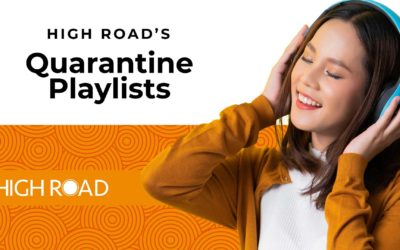You’re sitting at work, trying to get inspired for your writing project, or preparing a PowerPoint presentation for the board, or finally attacking the pile of email that’s overtaken your inbox. You turn on Spotify or Pandora or iTunes and grab a pair of headphones. Because, of course, music will help you be productive, right?
It’s certainly a question that’s worth asking.
Music permeates our culture when we’re shopping, when we’re driving, when we’re watching movies, or walking through the mall, or catching an Uber. As Gregory Ciotti says, “Music has a strange temporal permanence; as art decorates space, so does music decorate time.”
Scientists have been studying the links between music and productivity for decades and they’ve come to some pretty specific conclusions.
Music can positively affect our mood
Music, in general, makes us happy. Music releases dopamine and serotonin into our brains which helps us focus and relax. This helps with both focus during creative or concentration work as well as distraction from tension during mundane, repetitive tasks.
Dr. Teresa Lesiuk found that “the value of music listening… while working provided positive mood alteration.”
Music can help escape the noise of a workplace
Let’s be honest: sometimes you just need to escape the cacophony of a busy collaborative office. Employees sometimes just need to be able to concentrate and think, and the noise generated in a busy office is too distracting. A pair of headphones or a closed door with music is an effective way to escape that atmosphere.
Listen to what you know
The best kind of music for office listening is something you’re already familiar with because, as Gregory Ciotti also points out, “With familiar music, you know what lies ahead. Paying attention requires less focus.”
Ambient music is best for productivity
Ambient noise and sound machines used to be the preferred productivity focuser, but newer research suggests that music itself can be ambient if properly chosen.
Ergonomics found that continuous noise was the least annoying background noise while speech and lyrics was the most distracting. This would suggest that music without lyrics is preferable to music with lyrics, especially when the task requires concentration and focus. When you’re trying to create something with words, hearing other “intelligible” words run through your head can confuse your thought process.
Be sensitive to others in the workplace
Music preference is not a one-size-fits-all proposition. Some may work better to classical baroque while others are fine with 90’s pop running through the office Sonos. Try to find the least distracting common denominator for the PA and run your industrial grunge through your headphones.
A few suggestions of what to listen to
There are a lot of resources to find office music suggestions. Just use the power of Google and you’ll get bombarded with ideas. Here’s a few of my own suggestions:
- Starbucks shares many of their playlists on Spotify.
- HubSpot claims their productivity playlists are scientifically curated.
- Inverse offers a different Pandora station for each day of the week.
- I’ve often started Ott’s Skylon 70-minute album and not even noticed that an hour had passed.
- For a different (mostly) instrumental spin, Enigma fits the bill.
- Electronic for Studying, Beats for Studying, Classical for Studying, and Instrumental for Studying from Pandora are my typical go-to stations.






0 Comments